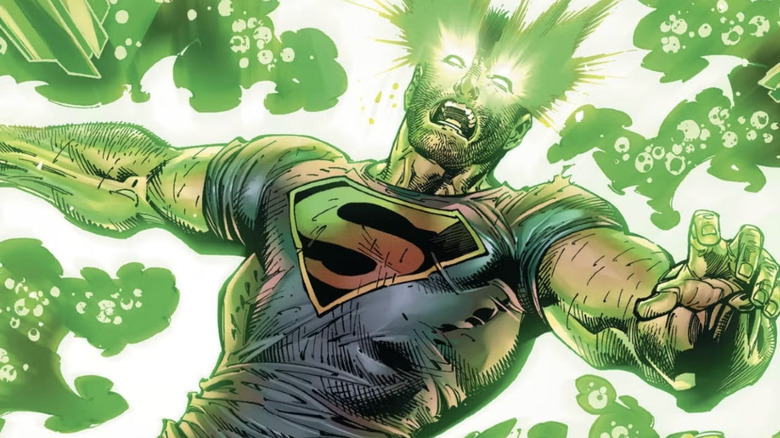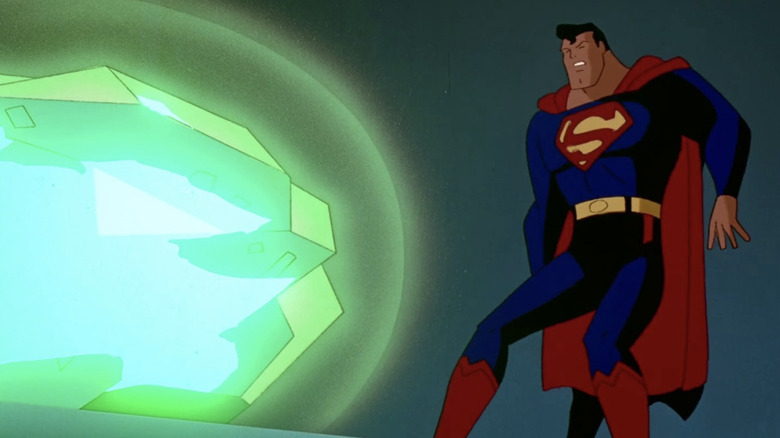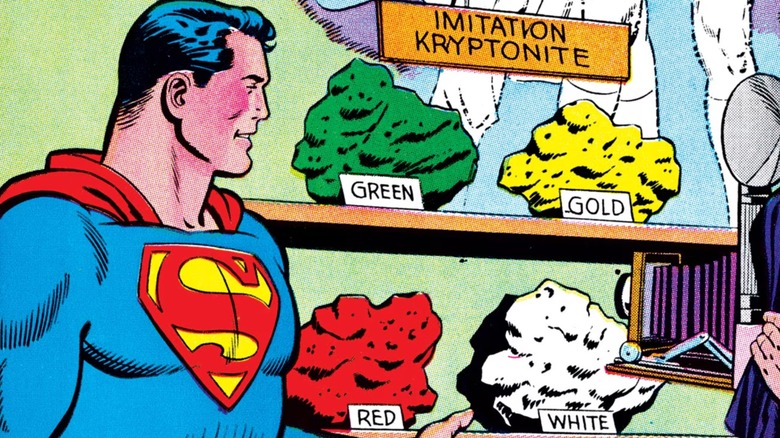Why Does Kryptonite Make Superman Weak?
Superman was the first fictional character to fully embody the archetype we now call a "superhero" — and as with any prototype, he didn't arrive fully formed. The Superman we know today is a fair bit different from the one who debuted in Jerry Siegel and Joe Shuster's "Action Comics" #1. He didn't fly, for one, nor were there any glowing green rocks called "Kryptonite" to weaken him.
As the good folks at DC Comics will tell you, Kryptonite first appeared in 1943 on the "Adventures of Superman" radio show. It then made it to the comics in 1949 and got its trademark green color in 1951.
When Superman is near Kryptonite, he'll show several classical symptoms of weakness: losing his equilibrium and collapsing, struggling to move, bleeding from his nose, etc. Depending on the version, the mineral either explicitly negates Superman's powers or just makes him too weak to fight. Generally, Kryptonite is depicted as originating from Superman's lost homeworld, Krypton. When Krypton exploded, fragments of Kryptonite within the planet followed baby Kal-El to Earth as meteors.
Kryptonite and its planet of origin are named for the real element Krypton, which manifests as a colorless gas, not glowing space rocks. While fictional, its lethality to Superman draws on the real science of radiation, wherein energy particles emit from a substance. When we come in contact with a radioactive substance, those particles will disrupt those in our own bodies, causing adverse health effects.
With Kryptonite being consistently written as a radioactive mineral, many writers have suggested that it's dangerous to humans too — just not immediately so like it is for Superman. During John Byrne's run on "Superman" in the 1980s, Lex Luthor started wearing a Kryptonite ring which ultimately gave him cancer. He had his right hand amputated and replaced with a robotic prosthetic, and of course, blamed Superman for his woes. Similarly, in the animated "Justice League" series, Lex contracted terminal blood poisoning from carrying around Kryptonite all the time. (As Batman will tell you from his fights with Superman, you have to shield the radiation with lead!)
Since Kryptonite has been part of Superman stories for decades, its presence now goes unquestioned. But why does it exist? There's a definite irony that something from Superman's home planet poisons him, and it simultaneously makes him feel like a more alien character, but why did this become his primary weakness?
Kryptonite was created to give Superman a weakness
Classical heroes, even seemingly invincible ones, have to have one weakness. We call this the "Achilles' Heel," because the defining example of a hero's weakness is in "The Iliad." Myths say the warrior Achilles' mother Thetis dunked him in the River Styx to make him invulnerable, but she missed the heel she held him by. When Achilles is shot in the heel with an arrow, it pierces his flesh and kills him.
Kryptonite is Superman's vulnerable heel — it's not as ubiquitous as "Achilles' Heel," but "Kryptonite" has also become synonymous with "single weakness" in the pop cultural lexicon. (Take 3 Doors Down's rock song "Kryptonite.")
Superman needs a weakness, that Kryptonite provides, because a completely invincible hero is not fun or engaging to watch (no one tell Mark Grayson). In an action narrative, if nothing can defeat your protagonist, there is no tension. Don't believe me? Take the word of late "Superman" editor Dorothy Woolfolk, who is widely credited with bringing Kryptonite into the comics. Without a weakness, she said, Superman would be "boring."
Kryptonite would be an especially effective storytelling tool for a radio serial; you could end one episode on a cliffhanger with Superman being trapped and weakened by Kryptonite, ensuring people would tune in next time to find out how he would escape. When it got brought over to the comics, it ensured that a normal man like Lex Luthor can believably be Superman's archnemesis; all Lex needs is a chunk of Kryptonite to level the playing field.
Many other Superman villains employ Kryptonite gimmicks. Metallo is a cyborg powered by Kryptonite. Titano, a King Kong-like ape, can shoot Kryptonite beams from his eyes. Bloodsport, played by Idris Elba in "The Suicide Squad," uses ammo forged from Kryptonite to make Superman less bulletproof. These villains can harm Superman, so he in turn has to expend care and energy fighting them, which makes his triumphs over them feel more earned.
The TV series "Smallville," which followed a young Clark Kent (Tom Welling), mashed up "Superboy" and "Buffy The Vampire Slayer." The "Smallville" villains of the week weren't demons, but normal people given powers by the Kryptonite meteors lying around Smallville; these one-off bad guys were collectively called "meteor freaks."
"Smallville," which leaned hard on Kryptonite as a MacGuffin and superpower-bestower, showed the same problem as the Silver Age (the '50s-'60s) "Superman" comics — use Kryptonite too much or make it too versatile, and it goes from easy suspense to narrative crutch.
All the different colors of Kryptonite in DC Comics, explained
"Normal" Kryptonite, the kind that makes Superman weak with its radiation, is colored green. But that's not the only Kryptonite shade there is. Most of these go back to the Silver Age when Superman comics were unapologetically goofy. Some prominent forms of Kryptonite, and their effects, include:
- Red Kryptonite: The most prominent of the abnormal variations (red is the complementary color of green, you know). Its effects tend to be random and inconsistent, with it sometimes being said that every different piece comes with a different effect. One common effect of Red Kryptonite, depicted throughout "Smallville" and "Batman: The Brave and the Bold" episode "Battle of the Superheroes!", is that it causes Superman to lose his inhibitions and become a caustic and selfish bully. In the comic "JLA: Tower of Babel," a piece of Red Kryptonite makes Superman's skin turn translucent — meaning his organs directly absorb solar energy and he suffers a painful, immobilizing overdose.
- Blue Kryptonite: This shade is harmless to Superman, and in fact can reverse Red Kryptonite poisoning. Instead, it negatively affects his evil twin, Bizarro. (Depending on the version, Bizarro can be either a clone or from an alternate dimension). Conversely, Bizarro is immune to Green Kryptonite, just as Superman is immune to Blue Kryptonite but harmed by the regular Green version. "Smallville" added some extra effects to Blue Kryptonite; its radiation also removes Superman's powers (temporarily, only so long as he's in close contact with it) and improves the health of normal humans.
- Gold Kryptonite: This one causes Superman to lose his powers — permanently. It is most memorably used in Alan Moore and Curt Swan's "Whatever Happened to the Man of Tomorrow?", written as an out-of-continuity ending to the Superman mythos. At the end of the story, Superman removes his powers via Gold Kryptonite and fakes his death, settling down with Lois Lane under the name "Jordan Elliot."
- White Kryptonite: Exposure to White Kryptonite kills plants and viruses. That's it. Watch out, Poison Ivy!
- Black Kryptonite: Debuting on "Smallville," Black Kryptonite can split individuals in two between their "Good" and "Evil" selves.
- Silver Kryptonite: Featured in "Smallville" as an invention of Brainiac, Silver Kryptonite causes Superman to become paranoid and delusional.
- Jewel Kryptonite: Created in the Phantom Zone, Jewel Kryptonite is used by the Phantoms to give themselves heightened psychic abilities.
- Platinum Kryptonite: A recent variation, introduced in 2018 by Tom King and Mikel Janín in "Batman: Secret Files" #1. Platinum Kryptonite gives Kryptonian superpowers to humans.
Will James Gunn's upcoming "Superman" feature yet another new shade to the Kryptonite rainbow? That remains to be seen, but I'm sure we'll be seeing some of the classic green K in the movie.


